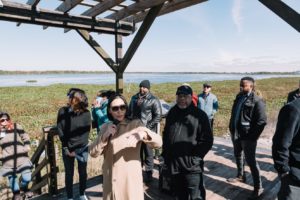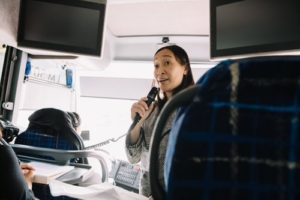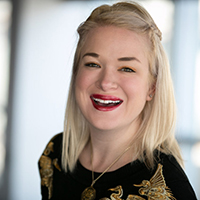By: Martha Cecilia Ovadia, Senior Associate for Equity Programs and Communications
Who are the people that make up The Funders Network? Know Your Network is an occasional Q&A series lifting up voices from across the network. In honor of the national Imagine a Day Without Water campaign on Oct. 21, TFN’s Martha Cecilia Ovadia chats — virtually, of course — with Elaine “Ella” Delio, director for environmental and regional initiatives at the Greater New Orleans Foundation. A co-chairperson of TFN’s Urban Water Funders steering committee, Ella also sits on the planning committee for the Urban Water Funders 2020 Virtual Meeting, which takes place Nov. 18-19. Responses have been edited for length and clarity.
Q : You are currently the director for environmental programs and regional initiatives for Greater New Orleans Foundation, but we hear you were trained in economics and finance before joining the sector. What drove your shift to environmental and climate issues?
I’ve always been interested in enterprise and business. I started off at Procter and Gamble in the Philippines, where I managed brands such as Vicks and Pringles. In 1998, when my mother had health issues, I was called to oversee our family’s businesses in the Philippines as the eldest of four children. My family’s businesses started as very small businesses that my parents literally ran from our home. These small businesses in logistics and security services grew from tens of employees to thousands of employees within 20 years. Managing these businesses helped me realize firsthand the importance of small and mid-sized businesses in the economic and social development of a country. This made me interested in the role of small and medium enterprises in a country’s development, which is why I decided to take my MBA and MPA. While at graduate school, I honed my skills in finance and economics because I had planned on going back to the Philippines and, hopefully, becoming part of the national government, perhaps as a department secretary.
It was at graduate school where I also read the book How to Change the World by David Bornstein. I learned about social entrepreneurs delivering positive social and environmental impacts all over the world. Reading this book led me to abandon a management consulting job offer in New York City and start work at a women’s small business development center called Center for Women Enterprise in Boston. (This is where I met and worked with the wonderful Alison Corwin of the Surdna Foundation ) [Note: Alison is also a TFN PLACES Fellowship alum.] We literally sat two feet apart from each other the whole day. At CWE, I helped high-growth potential women-led enterprises gain access to venture capital. This was important given that only 2% of venture capital in the early 2000s went to women-led firms. I worked with amazing women entrepreneurs and met inspiring ones such as Helen Greiner, founder of iRobot, and Mae Jemison, the first Black woman to travel to space. I also collaborated with venture capital and private equity investors in New England and New York in helping increase women-led businesses’ access to capital.
After getting married, I had to move to Washington D.C with my husband. An angel investor I worked with introduced me to the World Resources Institute (WRI), an environmental “think and do tank” which had an “access to capital” program similar to what I managed in Boston. It was a program called New Ventures, which provided business development and investment facilitation services to innovative environmental enterprises in Brazil, China, Colombia, India, Indonesia and Mexico. This is how I developed my expertise in the environment. WRI was also one of the foremost experts when it came to climate mitigation and it was one of the first environmental organizations that developed work on climate adaptation. Part of my work involved working with enterprises at the intersection of the environment and the “base of the pyramid,” a concept popularized by C.K. Prahalad. The base of the pyramid is the socio-economic group of the 2.7 billion people worldwide who live on less than a $2.50 a day. I had the honor of working with entrepreneurs who solved environmental issues but also contributed towards delivering better products and services for those who are at the base of the economic pyramid. One of them was S.K. Sharma, an entrepreneur and founder of SBA Hydro, who built and developed small-hydro power plants in partnership with communities in India to provide more reliable and cleaner energy for those who lived in poor, rural villages in India.

Q.: What brought you to philanthropy? Is there anything specific that has surprised you about working in the sector?
The Greater New Orleans Foundation (GNOF) is my first stint in philanthropy. I moved to New Orleans because my husband got his first job in academia here after obtaining his doctoral degree. When I was looking for a job in 2014, a couple of friends of mine spoke about the forward-looking work that GNOF was doing and that their building would be one of the first demonstration projects for green stormwater infrastructure in the city. That was intriguing to me given my previous work in the environment. My friend, Alison Corwin, had visited me in New Orleans in 2013 when she came for the Environmental Grantmakers Association Annual Retreat and told me that she had just started a job at the Surdna Foundation. This was the first friend of mine that joined philanthropy. When the position of director for environmental programs at GNOF opened up in 2014, Alison encouraged me to apply.
I had always thought that foundations just made grants. What has surprised me about working in the sector is how much community foundations work on the ground in partnership with non-profit partners and with government partners to solve critical issues. Moreover, in my work at GNOF, I have seen how a community foundation can help provide a platform for grassroots leaders to advocate to local or state governments for the needs and desired policies of their communities.
Q.: You are very involved in TFN’s Urban Water Funders working group. What is one thing you have learned working with Urban Water Funders that you think has been helpful or illuminating during this unprecedented time as we deal with the global coronavirus pandemic?
Since we decided to shift from being called the “Stormwater Funders” in 2017 to the Urban Water Funders, I think the Urban Water Funders working group increasingly centers racial equity in its programming as well as its aligned work. When the coronavirus pandemic happened, Urban Water Funders members immediately asked the question, “What kind of COVID-19-related programming can we offer not just to funder members but to their grantee partners as well?” In line with our equity focus, Urban Water Funders members agreed that it would be important to learn about how to advance water equity during the coronavirus recovery.
Given this, the TFN Urban Water Funders members, led by Sara Aminzadeh of Pisces Foundation organized a panel around this topic. One thing Ronda Chapman of PolicyLink made clear was how COVID-19 exposed the underinvestment and unjust city, state, and federal policies around water. For example, when COVID struck Detroit, there were 2,800 homes already experiencing water shutoffs. These homes were set back by not having access to water. Access to clean water is the most fundamental element for infection control and critical to good health. What I love about the Urban Water Funders is how relevant panels such as these can present bold ideas for consideration by funders. For example, Radhika Fox of the U.S. Water Alliance asked the group whether this is the time for philanthropy to provide funding to water utilities in order to support the end of water shutoffs. (Note: You can watch a recording of this Urban Water Funders panel here.)
Q.: You work with a lot of communities impacted by climate change at GNOF. What is one thing you wish folks knew about the people you are working with? What is the hardest part of doing this work?
The leaders that I work with serve communities impacted by climate change — from the Treme, the birthplace of Jazz which experiences localized flooding every year, to Dulac, home to many members of the United Houma Nation tribe and a land that is at risk of disappearing in the next 50 years due to coastal land loss and sea level rise. They have experienced various injustices and trauma in their lives. Despite that trauma and injustice, they continue to rise up time and again not just to help save their communities’ way of living and culture, but also their land, their neighborhood. I think the hardest part of doing work directly with community is hearing the hurt in their voices right after they experience an injustice or a disproportionate impact of climate change because of systemic racism. I am glad that GNOF is able to provide operating support to these leaders’ organizations. However, I ask myself what more can be done to help them with their restorative justice practices so that they can work towards a process of healing from the tremendous harm brought about by past injustices. One thing that I am working on in the regional affinity group that I belong to, the Greater New Orleans Funders’ Network, is experimenting on a pooled restorative justice fund for BIPOC leaders in Louisiana who work at the intersection of the environment and other issues.

Q.: You hosted the TFN PLACES Fellowship cohort a few years back and we learned so much about how water and climate work is actually justice work during that site visit to New Orleans. As you know, Imagine A Day Without Water is Oct. 21. Do you have any specific ways you honor that personally? Why do you think it is so important to elevate this day in the sector?
I will talk about how I honor “Imagine a Day Without Water” every year on a personal level. I spend some reflection time on my own to remember how I grew up in the Philippines without reliable access to clean water. From the time I was born until I was 17, I lived in a house where we had to put a sock over our faucet in order to filter particles. There were several years when we had limited access to water and had to save big containers of water when there was water available, so that we can use it when there was no water coming out of the tap. I learned how to take a bath with just 6 to 7 quarts of water. Because of this, I do not take the water that I have access to for granted. During this day, I also try remember those who live in other countries where women have to walk for hours just to gain access to water and bring home some for their families.
Q.: We always like to ask about home. With so many of us sheltering in place or unable to travel, can we live vicariously through you just for one question? What is your perfect day in New Orleans? Is there a secret place you wish everyone knew about?
A perfect day in New Orleans for me would be to watch my 11-year old daughter play soccer at The Fly, which has the amazing benefit of being on the Mississippi River. I would then go on a bike ride with my husband and two kids from our home in the Carrolton-Riverbend neighborhood to Parkway Bakery and Tavern in Bayou St. John, known for their po-boys, where we would have lunch. I would order a golden friend shrimp po-boy. (Parkway is also the location of one of the first demonstration projects for a permeable pavement parking lot). We would then bike to City Park, a park bigger than Central Park, which got flooded during Katrina but was redeveloped after The Storm. My kids would play in the playground right beside Café du Monde where my husband and I would be feasting on beignets and an iced-coffee. (This is very close to the place where Brad Pitt and Kate Winslet have a scene together in The Curious Case of Benjamin Button). Later that night, my husband and I would have dinner at Arnaud’s in the French Quarter where I would order gumbo for appetizer, meunière for my entrée, French 75 for my cocktail, and bananas foster for my dessert. After dinner, we would head over to Frenchmen Street and listen to some jazz at d.b.a., a bar where the greats such as John Boutté play.
Q.: And finally, it’s been a heck of a year. What is something you do as a practice of self-care, especially in 2020 when this work is so stressful and requires us to really rise to the occasion and be present on so many fronts?
It has indeed been a year. During this pandemic, what has helped me recover from the immense stress from different sources are a. bike rides around the Audubon Park (which is less than a mile from our house), and b. doing a weekend trip at least once a month with my family. For example, my family and I spent the Labor Day weekend in the North Shore of the Greater New Orleans region where there is a beautiful biking trail. During that weekend, we also went sailing on Lake Ponchartrain for the first time with a GNOF colleague who lived in the North Shore. Being in the midst of a big body of water had such a profound healing and calming effect on me.
Featured photo at top of post: Ella Delio (center) making introductions at the 2019 GREEN and Urban Water Funders annual meeting in New Orleans.
GNOF Disaster Response and Restoration Fund
Due to the impacts of Hurricanes Sally, Laura, Delta, and Tropical Storm Marco, the Greater New Orleans Foundation has activated its Disaster Response and Restoration Fund to provide assistance to those who are most in need.
TFN Urban Water Funders
For more information about TFN’s Urban Water Funders, contact Diane Schrauth at diane@fundersnetwork.org or at (856) 834-3755. Registration is now open for the Urban Water Funders 2020 Virtual Meeting Nov. 18-19.
 About the Author
About the Author
Martha Cecilia Ovadia is TFN’s Senior Program Associate for Equity Programs and Communications.

Ella has amazing story. So happy you highlighted it here.